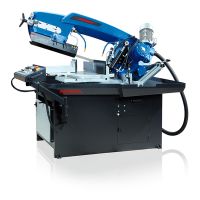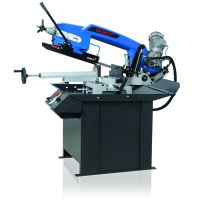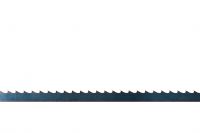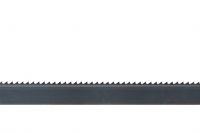There are a few major reasons why metal cutting bimetal blades can cut on an angle, or a ‘smile’ – the points we’ll go over in this article are:
- Tension
- Blade guides
- Tooth chipping
- Tooth wear
- Number of teeth in the cut
- Feed rate
Tension is very important to maintain a straight cut, especially where there is a wide cut. There are a lot of cutting forces working on that thin piece of metal that is a bandsaw blade, so if you can’t attain sufficient tension then nothing will be right! Generally speaking we recommend 30,000 PSI of tension for bimetal blades, though in most applications you won’t start running into serious problems until you have half that tension.
Blade guides likewise must be set to accurately take the twist out of the blade coming off the wheels, so that it is perfectly vertical to the base of the vice area. You can check this by placing a set square on the base of the vice area and sliding it up to the side of the blade, and checking for any visible gaps between the two. If there are gaps, either your guides need adjusting, replacing or both! See our upcoming article ‘Setting Bandsaw Blade Guides’ for a brief guide on how to accurately adjust blade guides.
Tooth chipping would in fact be the #1 cause we see for blades not cutting square, and particularly where they cut on a curve. It occurs when chipping happens on just one side of the teeth or set on a blade, causing the blade to ‘pull’ to the direction of the undamaged (or less damaged) side. The cause is almost always some kind of foreign material interference and is most likely to occur when the blade is brand new and at its most vulnerable. The likely culprits are:
- Hard spots in the material which happen to affect one side of the blade more than the other. There is very little you can do about this, other than call it rotten luck and maybe poor quality material.
- The machine is set to allow the blade to cut into the bed of the machine. If the blade has to try and slot into a previous cut in the bed, it will often enough chip the teeth on one side as it is entering.
- Machine parts such as guards and slow-approach arms (auto machines) which are loose and can interfere with the blade.
- Foreign objects on or in the material such as weld spatter, gravel from off the yard etc.
Tooth wear on one side of the blade is similar to tooth chipping and will have the same effect on your cut. The causes can be exactly the same too, just with the effect of wearing the teeth extra fast rather than chipping and is a more likely outcome when the blade isn’t brand new. There is one other cause to watch for, and that is to ensure the coolant is being evenly distributed. If your coolant outlet is pouring onto one side of the blade, that side is likely to remain sharper for longer and cause your blade to cut smiles!
General tooth wear can also cause a blade to cut wonky, because the teeth can no longer remove material at the rate the down feed is asking them, meaning the blade is attempting to force its way through the cut. The extra pressure resulting on the band can overcome the good work the guides and blade tension are doing. Either reduce the feed rate to a level the teeth can cope with, or switch out the blade.
Number of teeth in the cut can sometimes be the reason causing a crooked cut, and only happens when too many teeth are engaged with the material. Just as happens with a worn blade, too many teeth actually reduces the material removal power of the blade and if combined with an over-optimistic down feed rate, won’t speed up the cutting so much as cause the band to twist and writhe itself crooked within the cut. Reduce the down feed rate or better still, use a coarser tooth blade – remember the rule of no more than 22 teeth engaged in a cut (less is preferable).
The Feed rate has already been touched on in the previous 2 points, but the main thing to remember is that each tooth has constraints on how much material it can remove in a given timeframe. The material a tooth can remove changes over the lifetime of the blade, so for optimum performance the feed rate ideally needs to be adjusted as the blade gets blunter. Setting the machine at a rate higher than what the teeth can cope with may manifest itself in tooth strippage or in a crooked cut.
Ensure the blade is the correct one for the purpose, then aim to set the feed rate a margin below crooked cut/broken tooth territory!
If you are struggling to get to the bottom of crooked-cutting blades, please don’t hesitate to contact us.





